Second Word War
Gerd Grimm, a ‘half-Jew’, as a contemporary witness of the Second World War
The ‘Supplementary Card on Ancestry and Education’ as part of the ‘Population, Occupation and Business Census’ of 17 May 1938 shows that the Grimm family lived at Geranienstr. 4 in Karlsruhe. Grimm's father Eugen, born in 1881, was an engineer by profession. There is no information about the profession of his mother Rosie, who was born in 1885. She came from Allentown (Pennsylvania) and was considered a ‘full Jew’ according to Nazi ideology, while her (only) son Gerd was accordingly considered a ‘half-Jew’. Grimm's mother was one of 730 Jews from Baden who, on 22 October 1940, were not deported to the Gurs camp in southern France like 6,500 other Jewish citizens, but survived the war and the Nazi regime because of her marriage to an ‘Aryan’. At the time of the survey, Gerd Grimm himself, after completing his training at the art schools in Karlsruhe, Nuremberg and Berlin, had long been living at Kantstr. 4 in the Tiergarten district as a tenant of Sophie Bachtold. During the war, the apartment was bombed.
The American historian Brian Mark Rigg, who first came to public attention in 2003 with his sensational book "Hitler's Jewish Soldiers", contacted 430 former members of the Wehrmacht with Jewish roots as part of his project. He conducted two biographical interviews with Gerd Grimm in 1994 and 1996.
Grimm's career as one of Hitler's Jewish soldiers was short-lived. Even the ‘Wehrmacht's identification tag registers and change reports’ do not reveal exactly when it began. What is certain is that in 1940 he belonged to the 1st Company of Signal Battalion 231 in Rzeszow (eastern Poland), then served in the 1st Company of Tank Signal Battalion 92 at the beginning of 1941, and ended his military career a few weeks later in the 1st Company of Tank Signal Replacement Battalion 81 with the rank of ‘radio operator.’ On 23 January 1941, he was discharged with the usual note ‘unfit for military service.’
Nevertheless, he must have been quite popular among the troops, not least because of his gift for portraying people. ‘Gerd Grimm's company commander treated him with respect and told him that he regretted what he had to do, but that the Wehrmacht had ordered him to dismiss “half-Jews”.’ (Rigg, p. 160).
A handful of sketch sheets have survived, revealing him to be an attentive observer of his time, both during his time in the Wehrmacht and in the restless years that followed, when he is said to have frequently commuted between Berlin and the Black Forest. The spectrum of his subjects ranges from sharp caricatures of well-known Nazi leaders to portraits of ordinary comrades and snapshots of Polish farmers. Added to this are impressions from air-raid shelters and refugee treks from the later years of the war, which are as impressive as they are depressing.
The ‘Supplementary Card on Ancestry and Education’ as part of the ‘Population, Occupation and Business Census’ of 17 May 1938 shows that the Grimm family lived at Geranienstr. 4 in Karlsruhe. Grimm's father Eugen, born in 1881, was an engineer by profession. There is no information about the profession of his mother Rosie, who was born in 1885. She came from Allentown (Pennsylvania) and was considered a ‘full Jew’ according to Nazi ideology, while her (only) son Gerd was accordingly considered a ‘half-Jew’. Grimm's mother was one of 730 Jews from Baden who, on 22 October 1940, were not deported to the Gurs camp in southern France like 6,500 other Jewish citizens, but survived the war and the Nazi regime because of her marriage to an ‘Aryan’. At the time of the survey, Gerd Grimm himself, after completing his training at the art schools in Karlsruhe, Nuremberg and Berlin, had long been living at Kantstr. 4 in the Tiergarten district as a tenant of Sophie Bachtold. During the war, the apartment was bombed.
The American historian Brian Mark Rigg, who first came to public attention in 2003 with his sensational book "Hitler's Jewish Soldiers", contacted 430 former members of the Wehrmacht with Jewish roots as part of his project. He conducted two biographical interviews with Gerd Grimm in 1994 and 1996.
Grimm's career as one of Hitler's Jewish soldiers was short-lived. Even the ‘Wehrmacht's identification tag registers and change reports’ do not reveal exactly when it began. What is certain is that in 1940 he belonged to the 1st Company of Signal Battalion 231 in Rzeszow (eastern Poland), then served in the 1st Company of Tank Signal Battalion 92 at the beginning of 1941, and ended his military career a few weeks later in the 1st Company of Tank Signal Replacement Battalion 81 with the rank of ‘radio operator.’ On 23 January 1941, he was discharged with the usual note ‘unfit for military service.’
Nevertheless, he must have been quite popular among the troops, not least because of his gift for portraying people. ‘Gerd Grimm's company commander treated him with respect and told him that he regretted what he had to do, but that the Wehrmacht had ordered him to dismiss “half-Jews”.’ (Rigg, p. 160).
A handful of sketch sheets have survived, revealing him to be an attentive observer of his time, both during his time in the Wehrmacht and in the restless years that followed, when he is said to have frequently commuted between Berlin and the Black Forest. The spectrum of his subjects ranges from sharp caricatures of well-known Nazi leaders to portraits of ordinary comrades and snapshots of Polish farmers. Added to this are impressions from air-raid shelters and refugee treks from the later years of the war, which are as impressive as they are depressing.
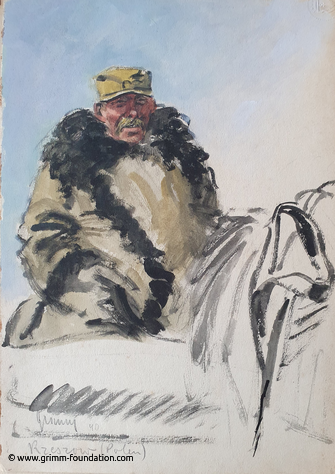
Bauer in Rzeszow, Polen, 1940
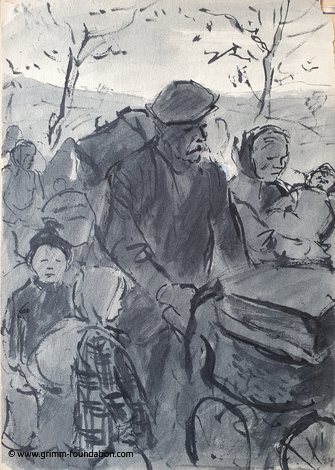
Fluechtlingstreck 1944

Goebbels, Goering, Hitler

Hitler, Goering
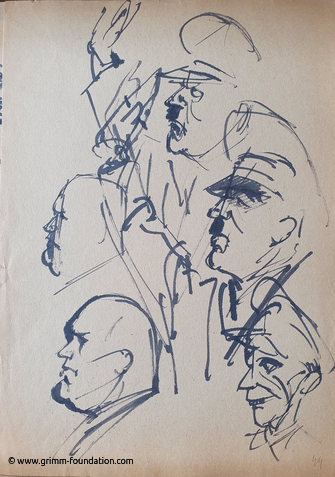
Hitler, Goering, Goebbels, 1944
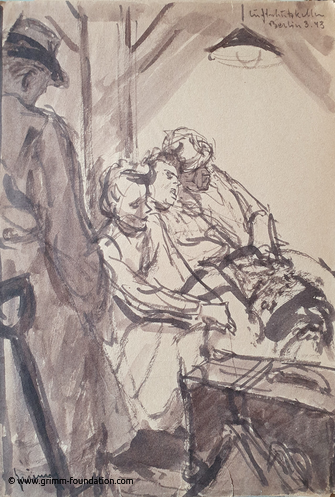
Luftschutzkeller, Berlin 1943
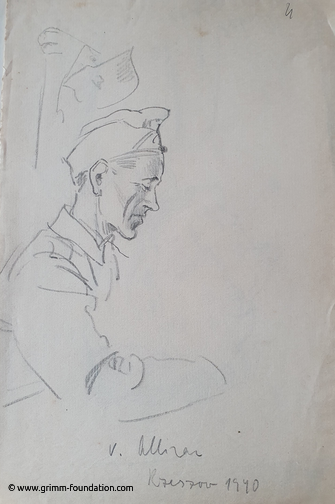
Portraet von Olliver, 1940
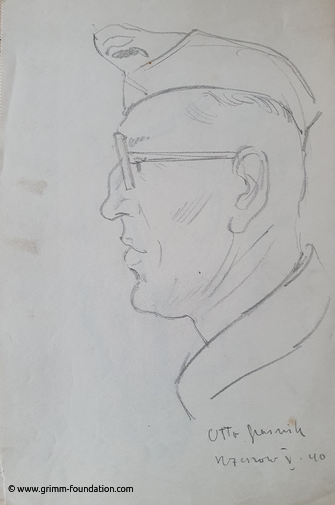
Portraet Otto Grasnik, 1940

Soldaten, rastend, 1940
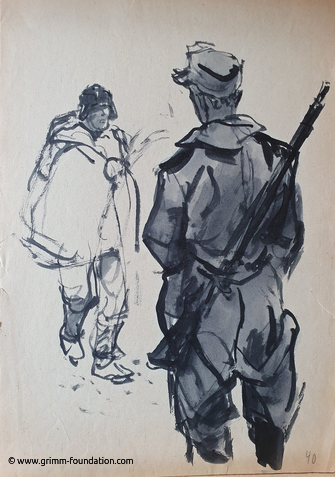
Zwei Soldaten, 1940
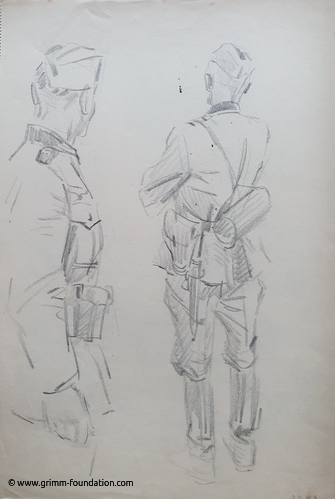
Zwei andere Soldaten, 1940
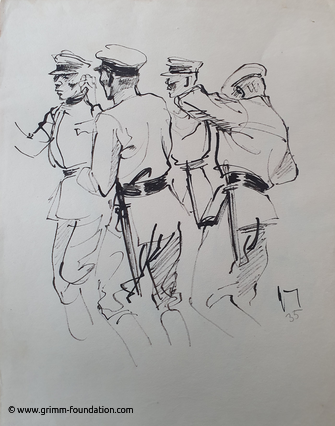
Uniformierte, 1935
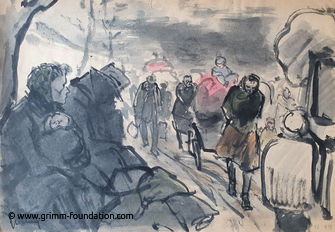
Fluechtlingstreck-1, 12-1944
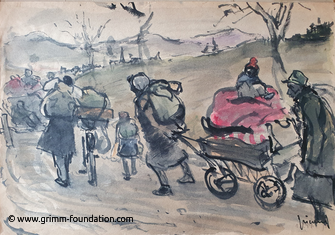
Fluechtlingstreck-2, 12-1944
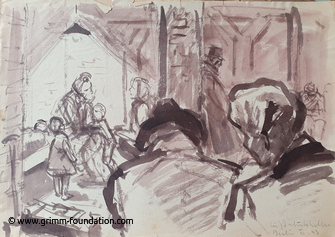
Luftschutzkeller, Berlin 1943
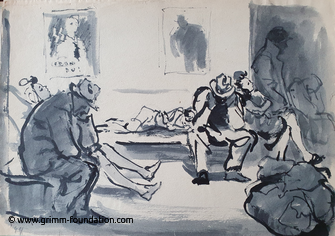
Luftschutzkeller, Kohlenklau
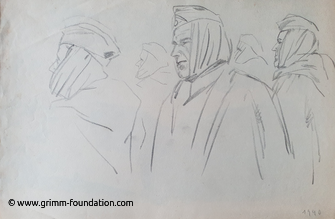
Verwundete Soldaten, 1940
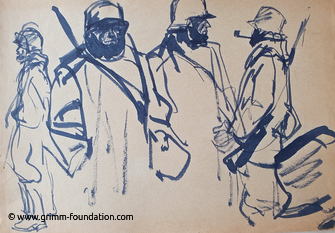
Soldaten in Winteruniform
